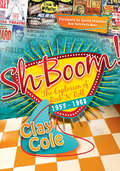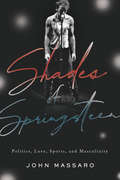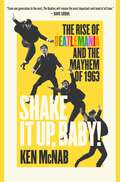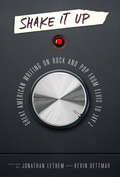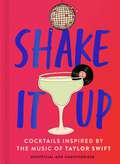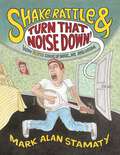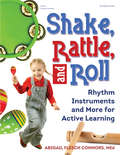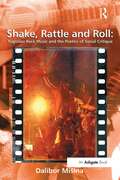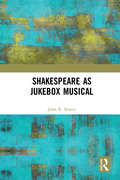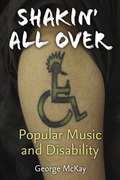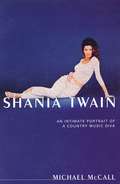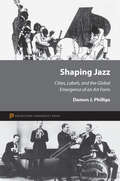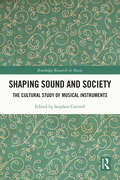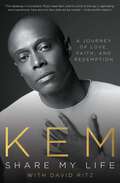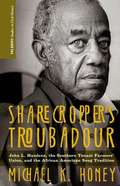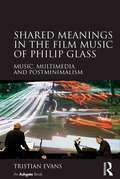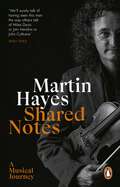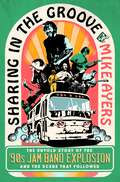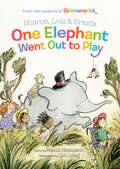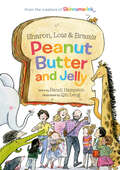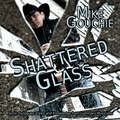- Table View
- List View
Sh-Boom!: The Explosion of Rock 'n' Roll, 1953–1968
by Clay ColeA rip-snorting rock &‘n&’ roll memoir from the legendary disc jockey who&’s been called &“the missing link to the Sixties.&” There was a small sliver of time between Bebop and Hip-Hop, when a new generation of teenagers created rock &‘n&’ roll. Clay Cole was one of those teenagers, as the host of his own Saturday night pop music television show. Sh-Boom! is the pop culture chronicle of that exciting time, 1953 to 1968, when teenagers created their own music, from swing bands and pop to rhythm and blues, cover records, a cappella, rockabilly, folk-rock, and girl groups; from the British Invasion to the creation of the American Boy Band. He was the first to introduce Chubby Checker performing &“The Twist&”; the first to present the Rolling Stones, Tony Orlando, Dionne Warwick, Neil Diamond, Bobby Vinton, the Rascals, the Ronettes, the Four Seasons, Dion, and dozens more; the first to introduce music video clips, discotheque, go-go girls and young unknown standup comedians Richard Pryor, George Carlin, and Fannie Flagg to a teenage television audience. But after fifteen years of fame, Clay walked away from his highly popular Saturday night show at the age of thirty—and remained out of the spotlight for over forty years. Well, he&’s missing no longer; he&’s back with a remarkable story to tell. Brimming with the gossip, scandal and heartbreak of the upstart billion-dollar music biz, Sh-Boom! is a breezy, behind-the-scenes look at &“live&” television, mom-and-pop record companies, and a boozy, Mafia-run Manhattan during the early days of rock &‘n&’ roll.
Shades of Springsteen: Politics, Love, Sports, and Masculinity
by John MassaroOne of the secrets to Bruce Springsteen’s enduring popularity over the past fifty years is the way fans feel a deep personal connection to his work. Yet even as the connection often stays grounded in details from his New Jersey upbringing, Springsteen’s music references a rich array of personalities from John Steinbeck to Amadou Diallo and beyond, inspiring fans to seek out and connect with a whole world’s worth of art, literature, and life stories. In this unique blend of memoir and musical analysis, John Massaro reflects on his experiences as a lifelong fan of The Boss and one of the first professors to design a college course on Springsteen’s work. Focusing on five of the Jersey rocker’s main themes—love, masculinity, sports, politics, and the power of music—he shows how they are represented in Springsteen’s lyrics and shares stories from his own life that powerfully resonate with those lyrics. Meanwhile, paying tribute to Springsteen’s inclusive vision, he draws connections among figures as seemingly disparate as James Joyce, Ta-Nehisi Coates, Thomas Aquinas, Bobby Darin, and Lin-Manuel Miranda. Shades of Springsteen offers a deeply personal take on the musical and cultural legacies of an American icon.
Shake It Up, Baby!: The Rise of Beatlemania and the Mayhem of 1963
by Ken McNabA vivid, captivating account of the Beatles&’s musical transformation throughout the pivotal year of 1963, as the world became caught up in the maelstrom of Beatlemania and its far-reaching cultural impact. The Beatles broke up more than half a century ago, yet millions around the globe are still drawn to the legacy of four lads from Liverpool. From the carefree innocence of "A Hard Day's Night" to the experimental psychedelia of "Lucy In The Sky With Diamonds,&” their message of love, peace, and hope still resonates. In Shake It Up, Baby! we go back to the start—to 1963, when they went from playing in small clubs in the remote Scottish Highlands to four number one singles, two number one albums, three national tours, and being besieged by thousands of fans at gigs all over Britain. Ken McNab tells the story through gripping, exclusive eye-witness accounts from those who were there: the Beatlemaniacs, the journalists, broadcasters, and television producers who were scrambling to make sense of it all—and the other bands who could only watch in awe as the Beatles went from bottom of the bill to headline act to the biggest band on the planet, forever transforming musical history.
Shake It Up: A Library of America Special Publication
by Jonathan Lethem Kevin DettmarTHE ESSENTIAL PLAYLIST OF GREAT WRITING ABOUT THE MUSIC THAT ROCKED AMERICA Jonathan Lethem and Kevin Dettmar's Shake It Up invites the reader into the tumult and excitement of the rock revolution through fifty landmark pieces by a supergroup of writers on rock in all its variety, from heavy metal to disco, punk to hip-hop. Stanley Booth describes a recording session with Otis Redding; Ellen Willis traces the meteoric career of Janis Joplin; Ellen Sander recalls the chaotic world of Led Zeppelin on tour; Nick Tosches etches a portrait of the young Jerry Lee Lewis; Eve Babitz remembers Jim Morrison. Alongside are Lenny Kaye on acapella and Greg Tate on hip-hop, Vince Aletti on disco and Gerald Early on Motown; Robert Christgau on Prince, Nelson George on Marvin Gaye, Luc Sante on Bob Dylan, Hilton Als on Michael Jackson, Anthony DeCurtis on the Rolling Stones, Kelefa Sanneh on Jay Z. The story this anthology tells is a ongoing one: “it’s too early,” editors Jonathan Lethem and Kevin Dettmar note, “for canon formation in a field so marvelously volatile—a volatility that mirrors, still, that of pop music itself, which remains smokestack lightning. The writing here attempts to catch some in a bottle.” Also features:NAT HENTOFF on BOB DYLAN AMIRI BARAKA on R&B LESTER BANGS on ELVIS PRESLEY ROBERT CHRISTGAU on PRINCE DEBRA RAE COHEN on DAVID BOWIE EVE BABITZ on JIM MORRISON ROBERT PALMER on SAM COOKE CHUCK KLOSTERMAN on HEAVY METAL JESSICA HOPPER on EMO JOHN JEREMIAH SULLIVAN on AXL ROSE ELIJAH WALD on THE BEATLES GREIL MARCUS on CHRISTIAN MARCLAY and much more.
Shake It Up: Delicious cocktails inspired by the music of Taylor Swift
by WelbeckTake a trip into the Taylor-verse with this collection of delicious cocktail recipes inspired by the songs of Taylor Swift. Featuring 65 cocktail recipes alongside top tips and stunning Taylor-inspired illustrations, this is a celebration of pop music's finest songbook and the perfect collection for the Swiftie in your life.Cocktails include:I Knew You Were DoubleWe Are Never Ever Getting Back TequilaMr. Perfectly WineNew Rum-anticsGetaway SidecarCruel SlammerFizz The Damn SeasonThe Last Great American DaiquiriAnd many more.
Shake It Up: Delicious cocktails inspired by the music of Taylor Swift
by WelbeckTake a trip into the Taylor-verse with this collection of delicious cocktail recipes inspired by the songs of Taylor Swift. Featuring 65 cocktail recipes alongside top tips and stunning Taylor-inspired illustrations, this is a celebration of pop music's finest songbook and the perfect collection for the Swiftie in your life.Cocktails include:I Knew You Were DoubleWe Are Never Ever Getting Back TequilaMr. Perfectly WineNew Rum-anticsGetaway SidecarCruel SlammerFizz The Damn SeasonThe Last Great American DaiquiriAnd many more.
Shake My Sillies Out
by RaffiA trio of animals who can't get to sleep roam the forest and eventually encounter a group of campers who join them in shaking their sillies out, clapping their crazies out, and yawning their sleepies out.
Shake, Rattle & Turn That Noise Down!: How Elvis Shook Up Music, Me & Mom
by Mark Alan StamatyFOR HIS EIGHTH birthday, Mark Alan Stamaty’s parents gave him his very own radio. Little did his mother realize that that innocent-looking plastic box would one day be the gateway for a new kind of sound that would “rock” her nearly out of her mind. . . .Mark first heard the howling thunder of Elvis Presley singing “Hound Dog” on the radio one lazy day and his life was forever changed. Soon he was styling his hair like the King and practicing his dance moves with a tennis racket as his pretend guitar in front o f the mirror. But his mother lived in constant fear that her son’s new love of rock ’n’ roll would turn him into a juvenile delinquent. Could Mark’s performance at his Cub Scout talent show change her mind?
Shake, Rattle and Roll: Rhythm Instruments and More for Active Learning
by Abigail Flesch ConnorsMusic and movement go together like books and reading--they spread joy! It's no secret that quiet doesn't always equal quality learning. At times, we struggle to help children settle down so they can listen and learn. However, we can also encourage them to move to the beat so they can listen and learn in more active ways. In Shake, Rattle, and Roll: Rhythm Instruments and More for Active Learning, you will find activities that inspire curiosity, exploration, and creativity. When children are singing, moving, listening, and playing music, their creative energy enhances their learning in many areas like Language Arts and Math. Because there is not just one right way to play rhythm instruments or move to the beat, children can explore their own capabilities while they dance, sing, and play.
Shake, Rattle and Roll: Yugoslav Rock Music and the Poetics of Social Critique (Ashgate Popular and Folk Music Series)
by Dalibor MišinaFrom the late-1970s to the late-1980s rock music in Yugoslavia had an important social and political purpose of providing a popular cultural outlet for the unique forms of socio-cultural critique that engaged with the realities and problems of life in Yugoslav society. The three music movements that emerged in this period - New Wave, New Primitives, and New Partisans - employed the understanding of rock music as the 'music of commitment' (i.e. as socio-cultural praxis premised on committed social engagement) to articulate the critiques of the country's 'new socialist culture', with the purpose of helping to eliminate the disconnect between the ideal and the reality of socialist Yugoslavia. This book offers an analysis of the three music movements and their particular brand of 'poetics of the present' in order to explore the movements' specific forms of socio-cultural engagement with Yugoslavia's 'new socialist culture' and demonstrate that their cultural praxis was oriented towards the goal of realizing the genuine Yugoslav socialist-humanist community 'in the true measure of man'. Thus, the book's principal argument is that the driving force behind the music of commitment was, although critical, a fundamentally constructive disposition towards the progressive ideal of socialist Yugoslavia.
Shakespeare as Jukebox Musical
by John R. SevernShakespeare as Jukebox Musical is the first book-length study of a growing performance phenomenon: musical adaptations of Shakespeare’s plays in which characters sing existing popular songs as one of their modes of communication. John Severn shows how these highly allusive works give rise to the pleasures of collaborative reception, and also lend themselves to political work, particularly in terms of identity politics and a valorisation of diversity. Drawing on musical theatre history, adaptation theory, Shakespeare studies and musicology, the book develops a critical approach that allows jukebox-musical versions of Shakespeare to be understood and valued both for their political potential and for the experiences they offer to audiences as artistic responses to Shakespeare. Case studies from the USA, the UK and Australia demonstrate how these works open new windows on Shakespeare’s plays and their performance traditions, on the wider jukebox musical trend, and on adaptation as an art form.
Shakin' All Over: Popular Music And Disability
by George MckayGiven the explosion in recent years of scholarship exploring the ways in which disability is manifested and performed in numerous cultural spaces, it’s surprising that until now there has never been a single monograph study covering the important intersection of popular music and disability. George McKay’s Shakin’ All Over is a cross-disciplinary examination of the ways in which popular music performers have addressed disability: in their songs, in their live performances, and in various media presentations. By looking closely into the work of artists such as Johnny Rotten, Neil Young, Johnnie Ray, Ian Dury, Teddy Pendergrass, Curtis Mayfield, and Joni Mitchell, McKay investigates such questions as how popular music works to obscure and accommodate the presence of people with disabilities in its cultural practice. He also examines how popular musicians have articulated the experiences of disability (or sought to pass), or have used their cultural arena for disability advocacy purposes.
Shania Twain
by Michael MccallShania Twain is not your average pop star. She has mega-hits like "You're Still the One", multi-platinum albums (Come on Over)...but she's much more than merely the sum of her success. Growing up in rural Canada amidst great poverty. Shania spent summers working for her father in a reforestation crew, learning how to handle an axe and wield a chainsaw as well as any man. At age 21, both her parents were killed in a magic car crash, and she was left to raise three younger siblings alone. The discipline and diligence she was forced to learn was then turned to her music career, with astounding results. From the cover of Rolling Stone to Country America, this cross-over wonder has charmed millions of music lovers around the world, and her fan base continues to grow Here, finally, is her whole story, complete with never-before-seen photos and insider information. This is the book Shania fans have been waiting for.
Shaped by Japanese Music: Kikuoka Hiroaki and Nagauta Shamisen in Tokyo (Current Research in Ethnomusicology: Outstanding Dissertations #10)
by Jay Davis KeisterShaped by Japanese Music is an in-depth analysis of the musical world of an individual performer, composer, and teacher. Using an ethnographic approach, this study situates musical analysis in the context of its creation, demonstrating that traditional Japanese music is hardly an archaic song form frozen in the present, but an active sociocultural system that has been reproduced in Japan from the seventeenth century to the present day. The dynamics of this cultural system unfold in the musical experiences of Kikuoka Hiroaki, the leader of a school of nagauta music, who struggled to modernize the art form while trying to maintain the qualities he believed to be fundamental to the tradition. Through the focus on Kikuoka's school, readers will become familiar with conflicts in the recent history of this music, traditional Japanese teaching methods, and the technique of modern composition within a traditional form. Underlying all of these different analyses is the concept of kata (form), a Japanese aesthetic that helps shape musical forms as well as the behaviour of musicians.
Shaping Jazz: Cities, Labels, and the Global Emergence of an Art Form
by Damon J. PhillipsThere are over a million jazz recordings, but only a few hundred tunes have been recorded repeatedly. Why did a minority of songs become jazz standards? Why do some songs--and not others--get rerecorded by many musicians? Shaping Jazz answers this question and more, exploring the underappreciated yet crucial roles played by initial production and markets--in particular, organizations and geography--in the development of early twentieth-century jazz.Damon Phillips considers why places like New York played more important roles as engines of diffusion than as the sources of standards. He demonstrates why and when certain geographical references in tune and group titles were considered more desirable. He also explains why a place like Berlin, which produced jazz abundantly from the 1920s to early 1930s, is now on jazz's historical sidelines. Phillips shows the key influences of firms in the recording industry, including how record companies and their executives affected what music was recorded, and why major companies would rerelease recordings under artistic pseudonyms. He indicates how a recording's appeal was related to the narrative around its creation, and how the identities of its firm and musicians influenced the tune's long-run popularity.Applying fascinating ideas about market emergence to a music's commercialization, Shaping Jazz offers a unique look at the origins of a groundbreaking art form.
Shaping Sound and Society: The Cultural Study of Musical Instruments (Routledge Research in Music)
by Stephen CottrellThis volume brings together leading voices from the new wave of research on musical instruments to consider how we can connect the material aspects of instruments with their social function, approaches that have been otherwise too frequently separated in musical scholarship. Shaping Sound and Society: The Cultural Study of Musical Instruments locates the instruments at the centre of cultural interactions. With contributions from ten scholars spanning a variety of methodologies and a wide range of both contemporary and historic music cultures, the volume is divided into three sections. Contributors discuss the relationships between makers, performers, and their local communities; the different meanings that instruments accrue as they travel over time and place; and the manner in which instruments throw new light on historic music cultures. Alongside the scholarly chapters, the volume also includes a selection of shorter interludes based on interviews with makers of comparatively new instruments, offering further insights into the process of musical instrument innovation. An essential read for students and academics in the fields of music and ethnomusicology, this volume will also interest anyone looking to understand how the cultural interaction of musical instruments is deeply informed and influenced by social, technological, and cultural change.
Share My Life: A Journey of Love, Faith and Redemption
by KemGrammy Award–nominated artist Kem shares his life in this revealing and remarkable memoir tracing his transformative journey from homelessness to gold-selling artist. Known for his smooth affecting crooning and dapper style, Kem&’s journey to the stage is nothing short of inspiring. In Share My Life, Kem goes back to the very beginning before his time to introduce his grandmother who worked as a sharecropper in the South and had thirteen children. As Kem&’s family rises from the sharecropping and ultimately lands in Detroit, there is an unspoken mantra of &“hard things are better left unsaid,&” which has devastating consequences down the line. And so, Kem grows up in the midst of an impenetrable silence. His mother is never without a beer in her hand, and his relationship with his father is oddly tense. Emotionally starved, Kem internalizes harmful feelings, eventually spiraling to drug use in his search for relief. At nineteen, Kem is homeless, roaming the cold Detroit streets. In the overly bright AA halls, Kem comes across men like himself verbalizing their feelings. The meetings helped him discover his own voice, using music as an outlet that has since touched millions. In Share My Life, Kem chronicles his incredible journey of self-discovery. The young boy who struggled with feelings of worthlessness becomes a man willing to put everything on the line for his dream.
Sharecropper’s Troubadour
by Michael K. HoneyFolk singer and labor organizer John Handcox was born to illiterate sharecroppers, but went on to become one of the most beloved folk singers of the prewar labor movement. This beautifully told oral history gives us Handcox in his own words, recounting a journey that began in the Deep South and went on to shape the labor music tradition.
Shared Meanings in the Film Music of Philip Glass: Music, Multimedia and Postminimalism
by Tristian EvansThe study of music within multimedia contexts has become an increasingly active area of scholarly research. However, the application of such studies to musical genres outside the 'classical' film canon, or in television and other media remains largely unexplored in any detail. Tristian Evans demonstrates how postminimal music interacts with other media forms, focusing on the film music by Philip Glass, but also taking into account works by other composers such as Steve Reich, Terry Riley, John Adams and others inspired by minimalist and postminimal practices. Additionally, Evans develops innovative ways of analysing this music, based on an interdisciplinary approach, and draws on research from areas that include philosophy, linguistics and film theory. The book offers one of the first in-depth studies of Philip Glass's music for film, considering The Hours and Dracula, Naqoyqatsi, Notes on a Scandal and Watchmen, while examining re-applications of the music in new cinematic and televisual contexts. The book will appeal to musicologists but also to those working in the fields of film music, cultural studies, media studies and multimedia.
Shared Notes: A Musical Journey
by Martin HayesMartin Hayes spent his childhood on a farm in County Clare, in a household steeped in musical tradition. After a free-spirited youth, he headed to the United States where he built a career that led to a life of musical performance on stages all over the world. Shared Notes traces this remarkable journey.Picking up his first fiddle at the age of seven, Hayes learned that music must express feeling. No amount of technical prowess can compensate for an absence of soulfulness. His interpretations of traditional Irish music are recognized the world over for their exquisite musicality and irresistible rhythm.Hayes has toured and recorded with guitarist Dennis Cahill for over twenty years, founded the Irish-American band The Gloaming, The Martin Hayes Quartet and The Common Ground Ensemble, and here, for the first time, tells his story of getting to the heart of the music.
Sharing in the Groove: The Untold Story of the '90s Jam Band Explosion and the Scene That Followed
by Mike AyersThe wild, untold oral history of the unlikely rise of Phish, Dave Matthews Band, Widespread Panic, Blues Traveler, and numerous other bands that helped define the 1990s Jam band sceneSharing in the Groove is a rich examination of an underdog genre that helped define the 1990s musical landscape—a scene that paved the way for modern-day cultural institutions such as the Bonnaroo Music Festival and kept the Grateful Dead ethos alive. It was also a world with its own values and its own unique interactions with fame, record labels, MTV, drugs, and success.Beginning in the mid-’80s and traveling up to New Year’s Eve 1999, the ’90s jam band story covers milestones such as getting signed to record labels and working the club scenes to playing amphitheaters and arenas. Along the way, details emerge of the scene’s own cultural values and the desire to be unique in a world that wanted them to follow a prescribed path. Ultimately, it’s a DIY story of creativity and making music—and how that won over a huge audience.Filled with anecdotes and stories directly from the musicians, promoters, managers, roadies, producers, label executives, and fans who lived this scene, Sharing in the Groove is a fun, fast-paced oral history that will appeal to music lovers everywhere.
Sharon, Lois and Bram's One Elephant Went Out to Play (Sharon, Lois & Bram's Classic Songs)
by Sharon Hampson Lois Lillienstein Bram Morrison Randi HampsonFrom the creators of Skinnamarink comes another picture book based on the classic counting song made famous by this beloved trio of children's entertainers.One elephant went out to play upon a spider's web one day. She had such enormous fun, that she called for her baby elephant to come.Sharon, Lois and Bram invite readers to join them in a musical story about a magical spider web. Jungle animals and kids in costume join in the fun on the web, including a glamorous giraffe, a cranky crocodile, a silly, smiley snake and five monkeys. After the 10th animal is invited onto the web, EVERYONE is invited to the party — but is the web strong enough? Through Qin Leng's wonderfully whimsical illustrations, this delightful picture book tells the story of a diverse group of children coming together in play and song.
Sharon, Lois and Bram's Peanut Butter and Jelly (Sharon, Lois & Bram's Classic Songs)
by Sharon Hampson Lois Lillienstein Bram Morrison Randi HampsonFrom the creators of Skinnamarink comes another picture book based on the classic sandwich song made famous by this beloved trio of children's entertainers.First you dig the peanuts and you dig 'em, you dig 'em, you dig 'em, dig 'em, dig 'em. Peanut, peanut butter, JELLY! Sharon, Lois & Bram invite readers to join them on an adventure to a magical place where a diverse group of animals and children come together to create the most delicious of snacks: a peanut butter and jelly sandwich! Accompanied by Qin Leng's wonderfully whimsical illustrations, this delightful picture book celebrates friends, community, music and a favorite tasty treat — mmm mmm mmmm!
Sharon, Lois and Bram's Skinnamarink (Sharon, Lois & Bram's Classic Songs)
by Sharon Hampson Lois Lillienstein Bram MorrisonNational bestseller — Based on the classic folk song made famous by a beloved trio of children's entertainers, this board book is best sung aloud! "Skinnamarink" is a timeless anthem of love and inclusion.What does "skinnamarink" mean? You may not find its definition in a dictionary, but the meaning is clear to the generations of children who sang along: friendship, happiness, sharing, community and, ultimately, love. This song has been sung in weddings and in classrooms. It can be fun and silly — especially with the accompanying actions! And it has a way of bringing people together. Through Qin Leng's wonderfully imaginative illustrations, this delightful board book tells the story of a community coming together. Young and old, from little mice to a big elephant, people and animals gather into a spontaneous parade as they follow the sound of music.Sharon, Lois and Bram formed as a trio of children's entertainers in Toronto in 1978 and went on to create two top-rated children's television shows, most notably The Elephant Show, and to release 21 full-length albums (many of which reached gold, platinum, double platinum and triple platinum). In 2018, Sharon and Bram celebrated their 40th anniversary and they continue to entertain children and share their message of love.
Shattered Glass
by Mike GouchieMike Gouchie is an indigenous Nashville recording artist. Over his musical career he’s had the privilege of opening for country legend George Jones on a cross Canada tour and has shared stages with Alan Jackson, Lonestar, Billy Currington, the Neville Brothers, Jo Nichols, and many others. A ten-time award-winning Country Recording Artist with deep Indigenous roots, Mike’s journey through the highs of the spotlight and the lows of life behind the curtain is as real as it gets. In Shattered Glass , he shares his raw and riveting story — an unfiltered look at the pursuit of a dream in an industry that rarely plays fair. Because sometimes, the ones who almost made it are the ones with the most powerful story to tell.
